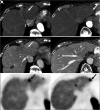Somatostatin Receptor Imaging and Theranostics: Current Practice and Future Prospects
- PMID: 34301785
- PMCID: PMC9364764
- DOI: 10.2967/jnumed.120.251512
Somatostatin Receptor Imaging and Theranostics: Current Practice and Future Prospects
Abstract
A new era of precision diagnostics and therapy for patients with neuroendocrine neoplasms began with the approval of somatostatin receptor (SSTR) radiopharmaceuticals for PET imaging followed by peptide receptor radionuclide therapy (PRRT). With the transition from SSTR-based γ-scintigraphy to PET, the higher sensitivity of the latter raised questions regarding the direct application of the planar scintigraphy-based Krenning score for PRRT eligibility. Also, to date, the role of SSTR PET in response assessment and predicting outcome remains under evaluation. In this comprehensive review article, we discuss the current role of SSTR PET in all aspects of neuroendocrine neoplasms, including its relation to conventional imaging, selection of patients for PRRT, and the current understanding of SSTR PET-based response assessment. We also provide a standardized reporting template for SSTR PET with a brief discussion.
Keywords: 68Ga-DOTANOC; 68Ga-DOTATATE; SSTR; neuroendocrine neoplasms; peptide receptor radionuclide therapy; somatostatin.
© 2021 by the Society of Nuclear Medicine and Molecular Imaging.
Figures





References
-
- Cives M, Strosberg JR. Gastroenteropancreatic neuroendocrine tumors. CA Cancer J Clin. 2018;68:471–487. - PubMed
-
- Krenning EP, Kwekkeboom DJ, Bakker WH, et al. . Somatostatin receptor scintigraphy with [111In-DTPA-d-Phe1]- and [123I-Tyr3]-octreotide: the Rotterdam experience with more than 1000 patients. Eur J Nucl Med. 1993;20:716–731. - PubMed
-
- Rufini V, Calcagni ML, Baum RP. Imaging of neuroendocrine tumors. Semin Nucl Med. 2006;36:228–247. - PubMed
